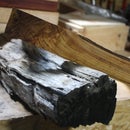Introduction: Marking Knife From a Dull Jigsaw Blade
Few things are worse than a dull jigsaw blade, but I always felt bad throwing them out. It seems like such a waste to toss out a piece of high speed steel because a few of the teeth have dulled out. It also doesn't make any sense to try and sharpen the teeth again, jig saw blades cost a few bucks for a five pack.
I'm not quite sure where the idea came from, but I realized that a jigsaw blade would make an excellent blade for a marking knife. To add a little style I'll be using an exotic pen blank. This is a simple, straightforward project that yields a great looking tool to use for years in the workshop.
Items needed:
Dull jigsaw blade
Pen blank
1/2" metal pipe. I used copper but any metal is fine
Epoxy
Tools:
Chisel/hand plane/ knife. Basically something to carve and shape the pen blank with
Drill and Drill Bit
Pipe cutter or hack saw
File
Hammer
Grinder or Bench Grinder
Sandpaper
Step 1: Setting the Blade
Clamp the square-ish blank to your work surface and drill a few holes side by side going into the pen blank. If you carefully start rocking the drill back and forth, you can carve out a large enough space for the blade to slide into. BE CAREFUL though, as small drill blades can break very easily.
I used a file to clean out the space a little bit, but it's not necessary. Periodically check the fit by tapping the blade into place.
Step 2: Shaping
With the hole drilled and cleaned out, begin shaping the handle. I used a small block plane to do the majority of the work, with a utility knife to finish out some of the finer details. A little bit of sanding smoothed everything out nicely.
For be, below a certain diameter a completely round handle is difficult to hold and my hand cramps up if I'm using it quite a bit. Simply rounding the edges over somewhat makes a much more ergonomic and comfortable tool to use I think.
Step 3: Fitting the Ferrule
A 1/4" thick piece of 1/2" copper pipe makes for a great ferrule. You don't need a ferrule, but it looks nice and provides some additional strength.
Just keep carving away a little bit of material at a time until the ferrule just barely fits over the end, then hammer it on the rest of the way.
A few light passes with the plane or knife will smooth the transition between the handle and ferrule.
Step 4: Epoxy Time
Mix up a small batch of two-part epoxy and smear it everywhere! Seriously, a dab into the hole, some on the surface, a bit around where the ferrule will mount, then quickly press everything into place.
A paper towel is handy for cleaning up any squeeze out
Step 5: Grind the Bevel
Marking knives are unique in that they're only beveled on one side. This allows you to press the knife flat against a straight edge and leave an incredibly precise cut line. It's much finer than a pencil.
Most jigsaw blades have an angled side at the end, and depending on which side of the blade you bevel, you'll have a right handed or left handed knife. No need to get fancy here, just simple grind a slight bevel on that angle and you're done.
Step 6: Finishing
Any finish will work. I happened to have danish oil lying around which is my go to finish for most woodworking projects. For an added bit of protection afterwards, I rubbed in a bit of furniture wax.
Step 7: Finished!
And that's it! You now have a tool ready for years of use in your shop.

Participated in the
Build a Tool Contest 2017













